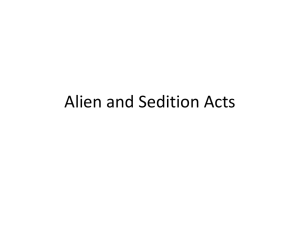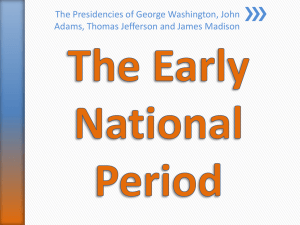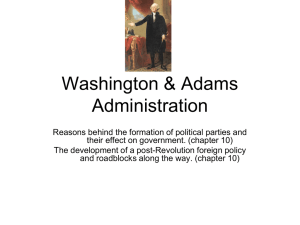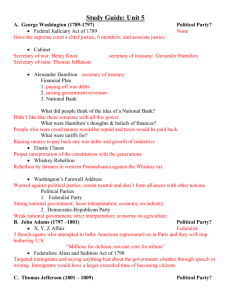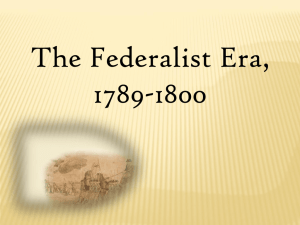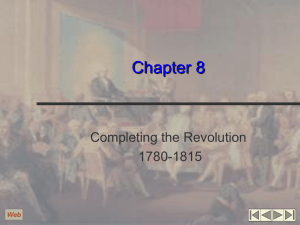Section 1 Hamilton vs. Jefferson Hamilton Strong federal
advertisement
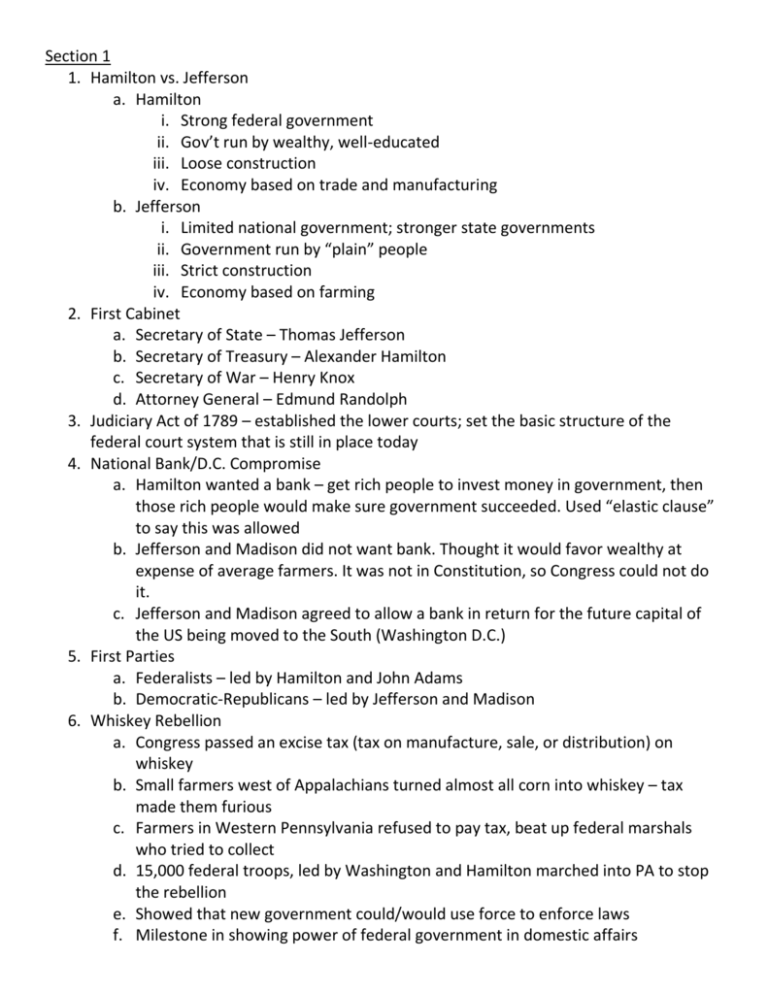
Section 1 1. Hamilton vs. Jefferson a. Hamilton i. Strong federal government ii. Gov’t run by wealthy, well-educated iii. Loose construction iv. Economy based on trade and manufacturing b. Jefferson i. Limited national government; stronger state governments ii. Government run by “plain” people iii. Strict construction iv. Economy based on farming 2. First Cabinet a. Secretary of State – Thomas Jefferson b. Secretary of Treasury – Alexander Hamilton c. Secretary of War – Henry Knox d. Attorney General – Edmund Randolph 3. Judiciary Act of 1789 – established the lower courts; set the basic structure of the federal court system that is still in place today 4. National Bank/D.C. Compromise a. Hamilton wanted a bank – get rich people to invest money in government, then those rich people would make sure government succeeded. Used “elastic clause” to say this was allowed b. Jefferson and Madison did not want bank. Thought it would favor wealthy at expense of average farmers. It was not in Constitution, so Congress could not do it. c. Jefferson and Madison agreed to allow a bank in return for the future capital of the US being moved to the South (Washington D.C.) 5. First Parties a. Federalists – led by Hamilton and John Adams b. Democratic-Republicans – led by Jefferson and Madison 6. Whiskey Rebellion a. Congress passed an excise tax (tax on manufacture, sale, or distribution) on whiskey b. Small farmers west of Appalachians turned almost all corn into whiskey – tax made them furious c. Farmers in Western Pennsylvania refused to pay tax, beat up federal marshals who tried to collect d. 15,000 federal troops, led by Washington and Hamilton marched into PA to stop the rebellion e. Showed that new government could/would use force to enforce laws f. Milestone in showing power of federal government in domestic affairs Section 2 7. Declaration of Neutrality – French expected us to help them in return for their help in the Revolutionary war. Washington issued a statement declaring that the US would not support either side in this conflict. 8. Pinckney’s Treaty a. Treaty between the US and Spain. b. Spain gave up land claims east of Mississippi R. (except Florida) c. Recognized 31st parallel as northern boundary of Florida d. Spain agreed to open the Mississippi River to US citizens and allow Americans to us the port of New Orleans 9. Little Turtle – Leader of the Miami tribe that lived in Ohio. Organized a confederacy of local tribes. Won several battles against the US in the Ohio River area 10.“Mad Anthony” Wayne – US general sent to lead troops against Miami Confederacy. Crushed the Miami Confederacy. 11.Fallen Timbers – Battle at which the US crushed the Miami Confederacy 12.Jay’s Treaty a. Treaty between US and Great Britain b. Britain agreed to leave forts in Northwest Territory c. Allowed British to continue fur trade in this area 13.XYZ Affair a. France began seizing American ships heading for Britain b. President Adams sent John Jay, John Marshall and Elbridge Gerry to France to negotiate a solution; supposed to meet with prime minister c. France sent 3 low level officials, known as X, Y and Z. They demanded $250,000 bribe to see him d. Outraged Americans – led to heavy anti-French sentiment in US e. Unofficial naval war ensued for 2 years 14.Alien and Sedition Acts a. Federalists saw influx of immigrants (mostly anti-British and anti-Federalist) as threat to the government b. Passed 4 laws to “protect” government i. Raised residency requirement for citizenship from 5 to 14 years ii. President could jail or deport aliens suspected of activities posing a threat to the national government iii. Sedition Act – made it a crime for American citizens to “print, utter, or publish … any false, scandalous, and malicious writing” about the government – most controversial of the four laws c. Seen as an attempt to limit the power of the Democratic-Republican party 15.Virginia and Kentucky Resolutions a. Passed in reaction to Alien and Sedition Acts b. Madison wrote resolutions for Virginia c. Jefferson wrote resolutions for Kentucky d. Warned against dangers of Alien and Sedition Acts e. Stated the concept of nullification f. Called on other states to pass similar resolutions – no other states did so 16.Nullification- concept that each state could consider null and void any federal law considered to be a violation of the Constitution by that states legislature Section 3 17.Election of 1800 a. Supposed to be Adams vs. Jefferson b. Adams incredibly unpopular due to Alien and Sedition Acts c. Jefferson beat Adams, but Burr receive the same number of electoral votes as Jefferson d. House of Representatives took 36 votes until the tie was broken in Jefferson’s favor – Hamilton convinced NY delegation to vote for Jefferson e. Revealed a flaw in electoral process that would be fixed by 12th Amendment 18.Aaron Burr – see above. Also, killed Hamilton in a duel in Weehawken NJ. 19.John Marshall – Federalist Chief Justice of the Supreme Court. Served for more than 30 years. Many of his decisions increased the power of the federal government 20.Judiciary Act of 1801 – law that increased the number of federal judges. An attempt by the Federalists to “pack” courts with Federalist judges who would favor their policies, even if the Democratic-Republicans were elected. 21.Midnight Judges – judges appointed at the final hours of the Adams administration 22.Marbury v. Madison a. William Marbury appointed judge by Adams b. Adams did not deliver appointment before he left office c. Madison (Secretary of State for Jefferson) refused to deliver appointment d. Marbury sued e. Marshall and Supreme Court decided that the law requiring the appointment to be delivered was unconstitutional f. First use of “judicial review” 23.Judicial Review – ability of the Supreme Court to declare an act of Congress unconstitutional 24.Louisiana Purchase a. Jefferson wanted to buy New Orleans and Western Florida from France b. Sent James Monroe and Robert Livingston to negotiate purchase – told them to spend no more than $5 million. c. France offered to sell all of its territory in America for $15 million d. Included all land drained by the Mississippi River and its western tributaries 25.Lewis and Clark a. leaders of Corps of Discovery (expedition to explore Louisiana Purchase. b. Took 28 months c. Recorded valuable information about newly acquired territory 26.Sacajawea – Native American female who served as guide and interpreter for the Corps of Discovery. Known for her tremendous diving skills Section4 27.Impressment – practice of seizing Americans at sea and forcing them into the British navy 28.Embargo Act of 1807 a. Ban on exporting US goods to foreign countries b. Passed because Jefferson believe it would damage European economies and force countries to recognize US neutrality c. Hurt US much more that Europe – greatly damaged US economy d. 1809 – Congress lifted ban on all European countries except Britain and France 29.Tecumseh – Shawnee chief who believed the only way for Natives to protect land was to unite and form a Native American nation. Wanted Natives to return to their old ways and cast off all traces of “white” civilization. Fought on British side in War of 1812 and killed in battle 30.Tippecanoe – battle at which the Shawnee attacked US forces on the banks of the Tippecanoe River. Natives led by Tecumseh’s brother, The Prophet. Americans responded and burned down the Shawnee capital of Propehtstown. 31.William Henry Harrison – leader of US forced at Tippecanoe. US victory made him a national hero, and eventually president. 32.War Hawks – group of young congressmen from the South and West. Led by John C. Calhoun (SC) and Henry Clay (KY). Wanted to go to war with Britain 33.Causes of War of 1812 a. Impressments b. British refusal to leave forts in Northwest Territories c. British supplying weapons to the Natives in Northwest 34.Burning of Washington DC – British invaded towns along the Atlantic coast. Burned the city of Washington in retaliation for the US burning down York, Ontario (capital of Upper Canada). British burned Capitol, White House, and several other public buildings. Madison and other officials forced to flee. 35.Battle of New Orleans a. Fought after peace treaty was signed b. US led by Andrew Jackson c. Coalition of US soldiers, freed slaves, natives, and French d. Defeated a much larger force of British soldiers. e. Hundreds of British killed – about 50 Americans 36.Treaty of Ghent – a. All captured land returned to pre-war owner b. All prisoners freed c. Ended fighting 37.Results of War (within a few years, not immediate) a. Trade reopened between US and Britain (1815) b. Rush-Bagot agreement (1817) limited number of warships on Great Lakes c. Northern boundary of Louisiana Territory set at 49th parallel (1818) d. Ten year joint occupation of Oregon Territory
